PR
X
Keyword Search
▼キーワード検索
Comments
続日本100名城東北の…
New!
オジン0523さん
【甥のステント挿入… New!
Gママさん
New!
Gママさん
2025年版・岡山大学… New!
隠居人はせじぃさん
New!
隠居人はせじぃさん
ムベの実を開くコツ… noahnoahnoahさん
noahnoahnoahさん
エコハウスにようこそ ecologicianさん
【甥のステント挿入…
 New!
Gママさん
New!
Gママさん2025年版・岡山大学…
 New!
隠居人はせじぃさん
New!
隠居人はせじぃさんムベの実を開くコツ…
 noahnoahnoahさん
noahnoahnoahさんエコハウスにようこそ ecologicianさん
Calendar
カテゴリ: 海外旅行
カイルモア修道院(Kylemore Abbey)の見学を終え、外に出る。
再び目の前に拡がる、 Pollacapall Lough・ポラカパル湖 を見る。
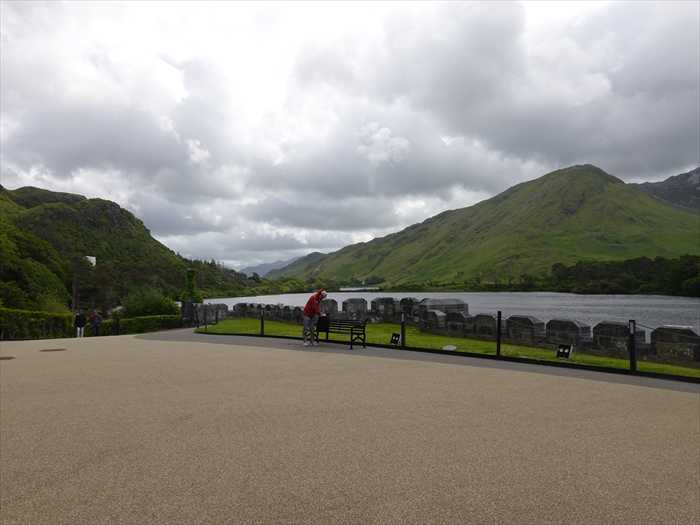

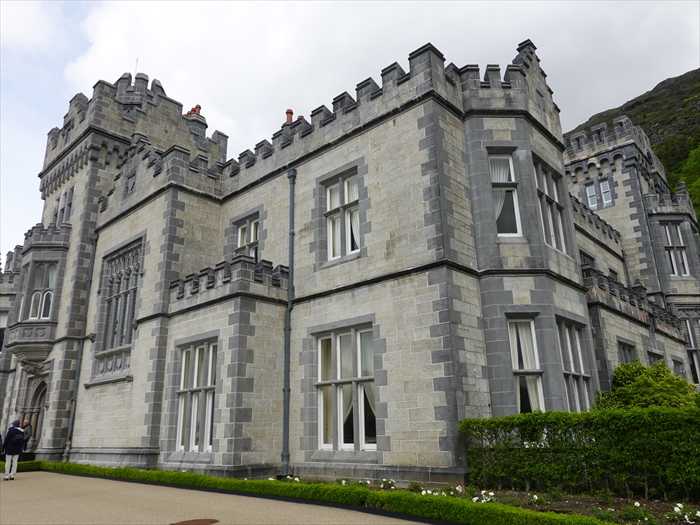
湖(Pollacapall Lough)のほとりにたたずむその姿は、鏡のような湖面に完璧に映り込む
白い幻想のような建物。
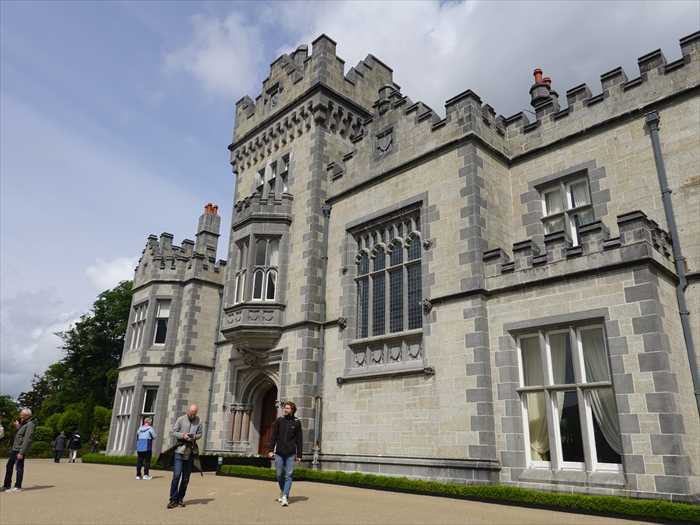

建物の背後には ダイヤモンド山脈(Twelve Bens) の森と山が広がり、灰色の石造りの建物は
その自然と一体化しているかのようであった。
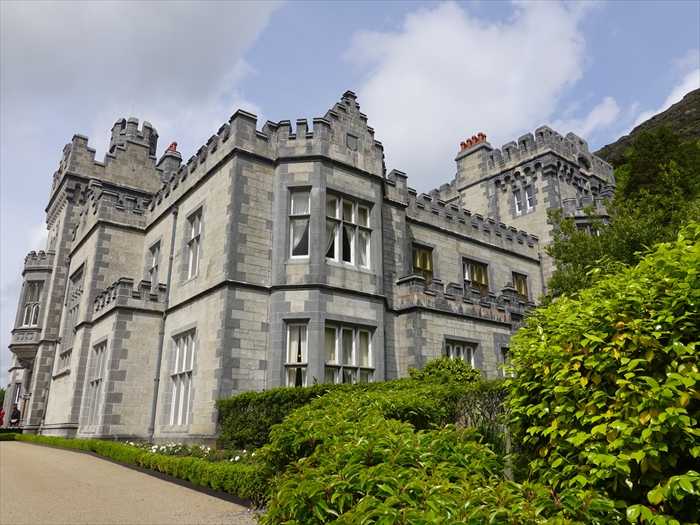
チリランタンの木 (Chilean Lantern Tree)。
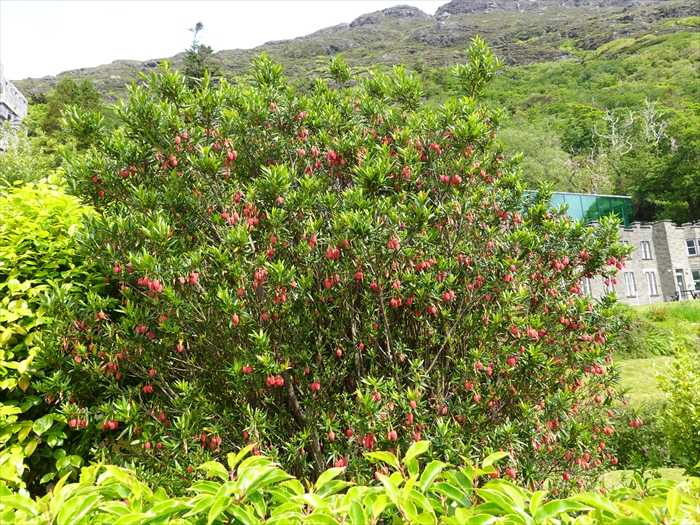
チリランタンツリーはマツ科に属する8種の顕花植物を含む植物属。
それらはチリの森林原産の常緑低木または小さな木。
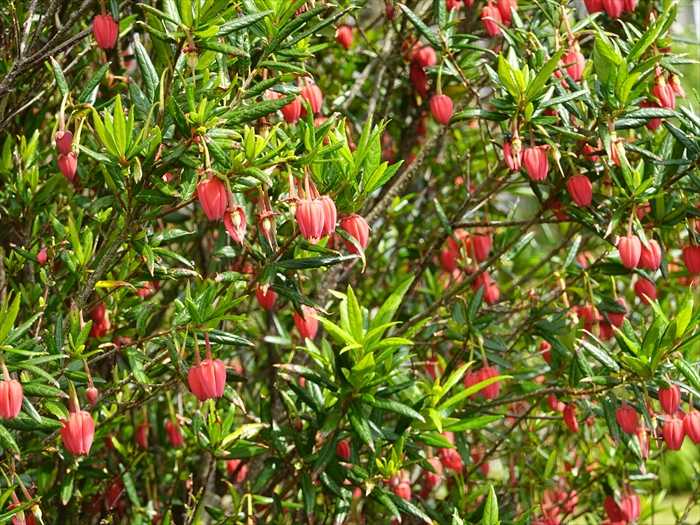
敷地内にある 祈りの場(マリア像の洞窟) にあった ルルドの洞窟 を模した 聖母マリア像 。
フランス南部の聖地「ルルド(Lourdes)」にある有名な洞窟にインスピレーションを得て、
世界中のカトリック施設ではこのような岩に囲まれたマリア像の祈りの空間を再現している と。
白いローブに青い帯をまとった姿は、「無原罪の御宿りの聖母マリア(Our Lady of the
Immaculate Conception)」の典型的な表現。
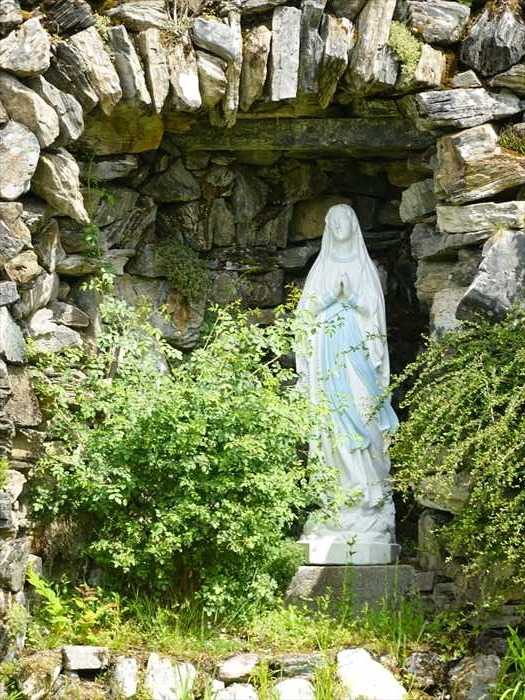
対岸の山々をズームして。
湖の向こうに見える山々は、 Duchruach(ドゥクルーア)やその周辺の峰々 であろう。
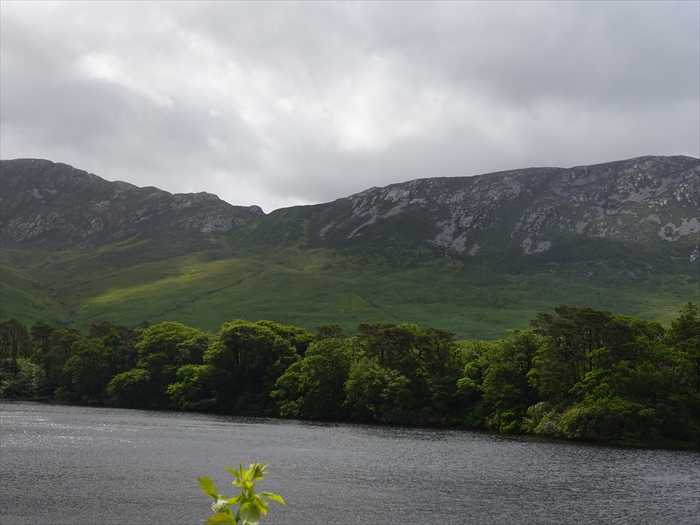
山の斜面から水の流れも。
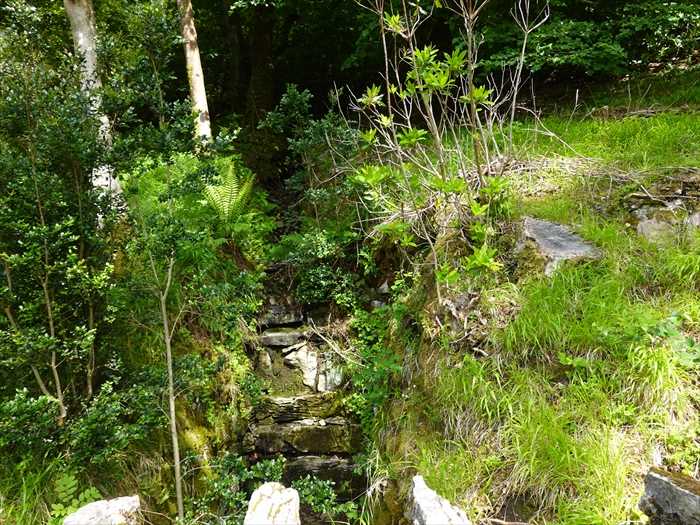
ヨーロッパでよく見られる コブハクチョウ(英名:Mute Swan)。

ズームして。
嘴がオレンジ色で、根元に黒い「コブ」

Duchruach(ドゥクルーアク)山 (アイルランド語で「暗い尾根」の意味) 。
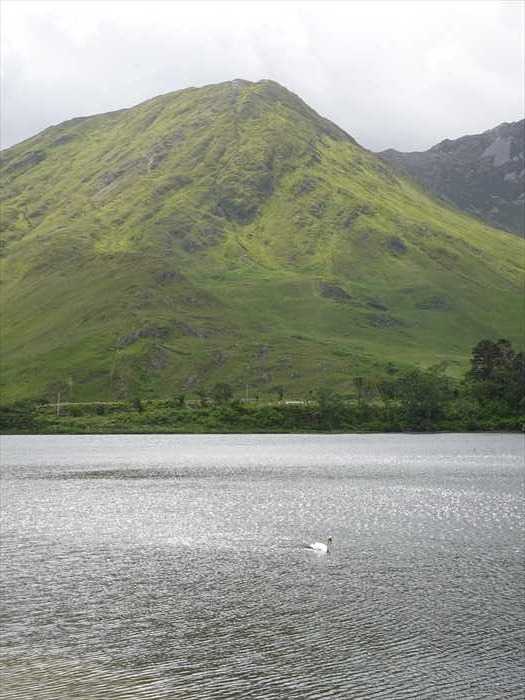
「LAKE WALK」 案内板。
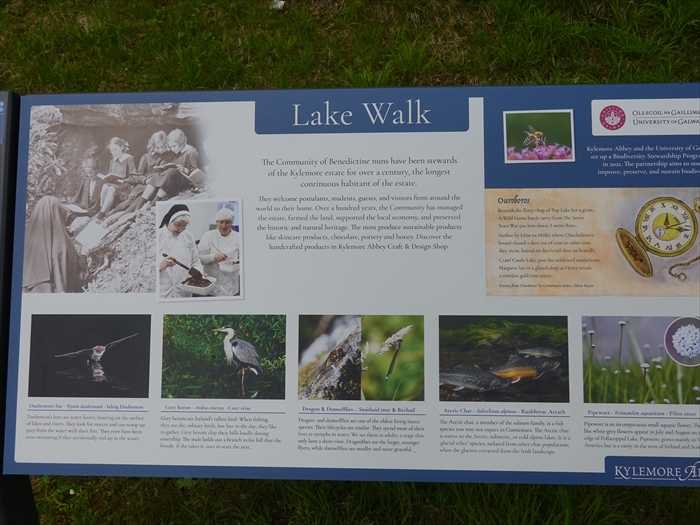
「 LAKE WALK
【 湖の遊歩道(Lake Walk)
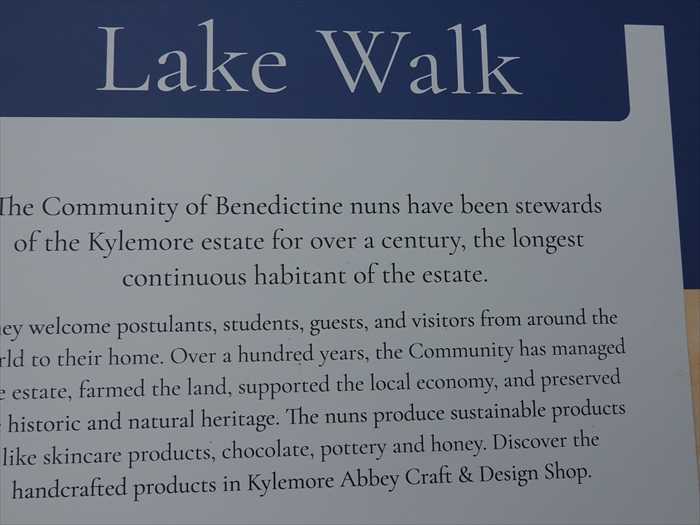
Letterbreckaun(レターブレカン)山 か?
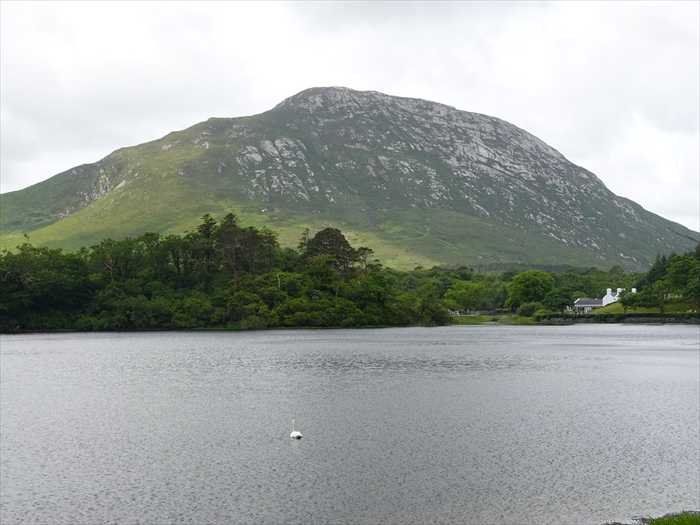
ここにも
「 Lake Walk

「 MEET THE Monterey Pine

「 Gothic Church
再び目の前に拡がる、 Pollacapall Lough・ポラカパル湖 を見る。

名前の由来:「Pollacapall」はアイルランド語で、おそらく
「Poll a' Chapall(馬の穴/水たまり)」に由来すると考えられます。
「Poll a' Chapall(馬の穴/水たまり)」に由来すると考えられます。
capall=馬
→ 「馬が水を飲みに来たような場所」という意味が込められている可能性
があります と。
この湖は自然湖でありながら、19世紀に建設されたカイルモア城(現・修道院)と庭園の一部
として、景観整備が加えられているのであった。
この湖は自然湖でありながら、19世紀に建設されたカイルモア城(現・修道院)と庭園の一部
として、景観整備が加えられているのであった。

厚みのある石壁は、まるで時を超えて守られてきた祈りと物語の砦のよう。
貴族の私邸として建てられ、修道院として生まれ変わったこの建物には、
愛・喪失・再生の歴史が刻まれているのであった。
愛・喪失・再生の歴史が刻まれているのであった。

湖(Pollacapall Lough)のほとりにたたずむその姿は、鏡のような湖面に完璧に映り込む
白い幻想のような建物。

尖塔(せんとう)やアーチ窓、装飾の細部までが19世紀ゴシック・リヴァイヴァル様式
(ネオ・ゴシック)を反映。
(ネオ・ゴシック)を反映。
縦に伸びる構造が、空へ祈りを捧げるような精神性を感じさせるのであった。

建物の背後には ダイヤモンド山脈(Twelve Bens) の森と山が広がり、灰色の石造りの建物は
その自然と一体化しているかのようであった。

チリランタンの木 (Chilean Lantern Tree)。

チリランタンツリーはマツ科に属する8種の顕花植物を含む植物属。
それらはチリの森林原産の常緑低木または小さな木。

敷地内にある 祈りの場(マリア像の洞窟) にあった ルルドの洞窟 を模した 聖母マリア像 。
フランス南部の聖地「ルルド(Lourdes)」にある有名な洞窟にインスピレーションを得て、
世界中のカトリック施設ではこのような岩に囲まれたマリア像の祈りの空間を再現している と。
白いローブに青い帯をまとった姿は、「無原罪の御宿りの聖母マリア(Our Lady of the
Immaculate Conception)」の典型的な表現。

対岸の山々をズームして。
湖の向こうに見える山々は、 Duchruach(ドゥクルーア)やその周辺の峰々 であろう。

山の斜面から水の流れも。

ヨーロッパでよく見られる コブハクチョウ(英名:Mute Swan)。

ズームして。
嘴がオレンジ色で、根元に黒い「コブ」

Duchruach(ドゥクルーアク)山 (アイルランド語で「暗い尾根」の意味) 。
標高:約550メートル
welve Bens(トゥエルブ・ベンズ)山脈の一部
。

「LAKE WALK」 案内板。

「 LAKE WALK
The community of Benedictine nuns have been stewards of the Kylemore estate for over
a century, the longest continuous habitant of the estate.
Over a hundred years , the Communiry has managed the estate,farmed the land,
supported the local economy, and preserved the historic and natural heritage. The nuns
produce susrainable products like skincare products, chocolate, pottery and honey.
Discover the handcrafted products in Kylemore Abbey Craft & Design Shop.」
a century, the longest continuous habitant of the estate.
Over a hundred years , the Communiry has managed the estate,farmed the land,
supported the local economy, and preserved the historic and natural heritage. The nuns
produce susrainable products like skincare products, chocolate, pottery and honey.
Discover the handcrafted products in Kylemore Abbey Craft & Design Shop.」
【 湖の遊歩道(Lake Walk)
ベネディクト会の修道女たちは、100年以上にわたりカイルモアの地を守り続けてきた
管理者(スチュワード)であり、この地で最も長く暮らす共同体 。
管理者(スチュワード)であり、この地で最も長く暮らす共同体 。
彼女たちは志願者(ポスチュラント)や学生、宿泊者、そして世界中からの訪問者を」この「家」へ
温かく迎え入れています。
温かく迎え入れています。
この100年の間に、修道女たちは:広大な敷地を管理し、農業を営み、地域経済を支え、歴史的・
自然遺産を守ってきました。
自然遺産を守ってきました。
また、彼女たちは環境に配慮した持続可能な製品も手がけており、スキンケア用品、チョコレート、
陶器、はちみつなどを製造しています。
こうした手作りの品々は、敷地内の「カイルモア修道院クラフト&デザインショップ」で
ご覧いただけます。】
ご覧いただけます。】

Letterbreckaun(レターブレカン)山 か?

ここにも
「 Lake Walk
Did you know that Kylemore's woodland is a temperate rainforest?
Ireland is situated at a northern lattitude, only 15 degrees south of the Arctic Circle,
the same latitude as Newfoundland in Canada. Yet the lrish climate originating in the
Gulf of Mexico, gives Connemara high humidiry, high rainfall, and minor fluctuation in
average mild temperatures. This creates perfect conditions for a forest with layered
vegetation rich in lichens,mosses,ferns,and epiphytes.These woodlands,associated
with native species,are confined to western Ireland and Britain and form a unique
habitat.」
【 レイク・ウォーク情報:カイルモアの森は温帯雨林?
ご存知でしたか?カイルモアの森林は「温帯雨林(テンペレート・レインフォレスト)」なのです。
アイルランドは北緯に位置し、北極圏からわずか15度南、カナダのニューファンドランド島と
同じ緯度にあります。
しかし、メキシコ湾からの暖流(ガルフ・ストリーム)によってもたらされる気候は、
コネマラ地方において
・高い湿度
・豊富な降水量
・穏やかで安定した気温
を生み出しています。
このような気象条件は、以下のような多層的な植生をもつ森を育むのに理想的です:
・地衣類(リケン)
・苔(モス)
・シダ(ファーン)
・着生植物(エピファイト)
これらの温帯雨林型の森林は、アイルランド西部およびイギリスの一部にのみ分布し、
きわめて限られた希少な生態系を形成しています。】
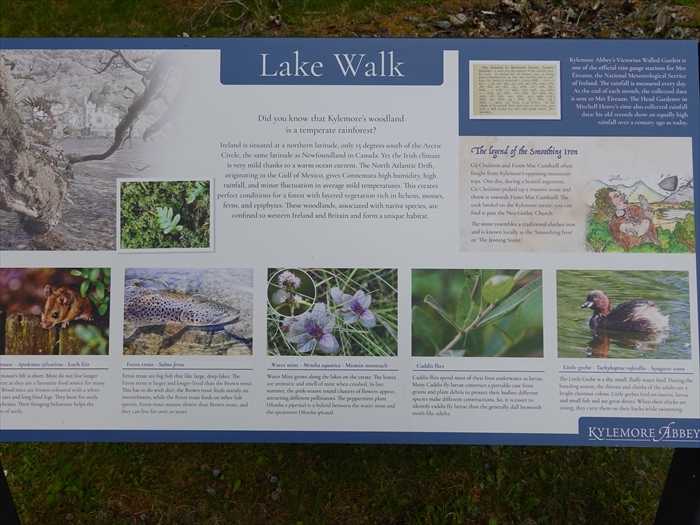
「 THE Monterey Pine・ モントレーパイン 」 。
Ireland is situated at a northern lattitude, only 15 degrees south of the Arctic Circle,
the same latitude as Newfoundland in Canada. Yet the lrish climate originating in the
Gulf of Mexico, gives Connemara high humidiry, high rainfall, and minor fluctuation in
average mild temperatures. This creates perfect conditions for a forest with layered
vegetation rich in lichens,mosses,ferns,and epiphytes.These woodlands,associated
with native species,are confined to western Ireland and Britain and form a unique
habitat.」
【 レイク・ウォーク情報:カイルモアの森は温帯雨林?
ご存知でしたか?カイルモアの森林は「温帯雨林(テンペレート・レインフォレスト)」なのです。
アイルランドは北緯に位置し、北極圏からわずか15度南、カナダのニューファンドランド島と
同じ緯度にあります。
しかし、メキシコ湾からの暖流(ガルフ・ストリーム)によってもたらされる気候は、
コネマラ地方において
・高い湿度
・豊富な降水量
・穏やかで安定した気温
を生み出しています。
このような気象条件は、以下のような多層的な植生をもつ森を育むのに理想的です:
・地衣類(リケン)
・苔(モス)
・シダ(ファーン)
・着生植物(エピファイト)
これらの温帯雨林型の森林は、アイルランド西部およびイギリスの一部にのみ分布し、
きわめて限られた希少な生態系を形成しています。】

「 THE Monterey Pine・ モントレーパイン 」 。

「 MEET THE Monterey Pine
Common name: Monterey Pine
Botanical name: Pinus radiata
Irish name: Péine Monterey
The Monterey pine is unmistakably one of the most imposing trees on the
Kylemore estate. This tree is native to only three places: Monterey in California,
just south of San Francisco, and the islands of Guadalupe and Cedros off
the California Baja Mexican coast.
Kylemore estate. This tree is native to only three places: Monterey in California,
just south of San Francisco, and the islands of Guadalupe and Cedros off
the California Baja Mexican coast.
The Monterey pine, like many other American west coast tree species, was “discovered”
by David Douglas, a Scottish botanist. The first seeds were sent to the British Isles
in 1831. This pine grows well in Kylemore’s mild oceanic climate, growing an incredible
one meter a year for up to 30 years.
by David Douglas, a Scottish botanist. The first seeds were sent to the British Isles
in 1831. This pine grows well in Kylemore’s mild oceanic climate, growing an incredible
one meter a year for up to 30 years.
The Monterey pinecones stay on the branches until hot weather, or a forest fire opens them up to free the seeds. In hot summers, the Monterey pines have been known to self-seed on our estate. 」
【 モントレーパインをご紹介
【 モントレーパインをご紹介
一般名:モントレーパイン
学名:Pinus radiata(ピヌス・ラジアータ)
アイルランド名:Péine Monterey
モントレーパインは、カイルモアの敷地内で最も堂々とした木のひとつとして、ひと目で
わかります。この木が自生しているのは、カリフォルニア州モントレー(サンフランシスコ南部)
と、メキシコ・バハカリフォルニア沖のグアダルーペ島およびセドロス島の3か所だけです。
わかります。この木が自生しているのは、カリフォルニア州モントレー(サンフランシスコ南部)
と、メキシコ・バハカリフォルニア沖のグアダルーペ島およびセドロス島の3か所だけです。
他のアメリカ西海岸の樹種と同様に、モントレーパインはスコットランドの植物学者
デイヴィッド・ダグラスによって「発見」されました。最初の種は1831年にイギリス諸島に
送られました。この松はカイルモアの穏やかな海洋性気候によく適しており、最大30年間で
年間1メートルも成長することがあります。
デイヴィッド・ダグラスによって「発見」されました。最初の種は1831年にイギリス諸島に
送られました。この松はカイルモアの穏やかな海洋性気候によく適しており、最大30年間で
年間1メートルも成長することがあります。
モントレーパインの松ぼっくりは、暑い気候や山火事が種子を放出するまで枝についたままです。
暑い夏には、敷地内で自然に発芽することも知られています。 】
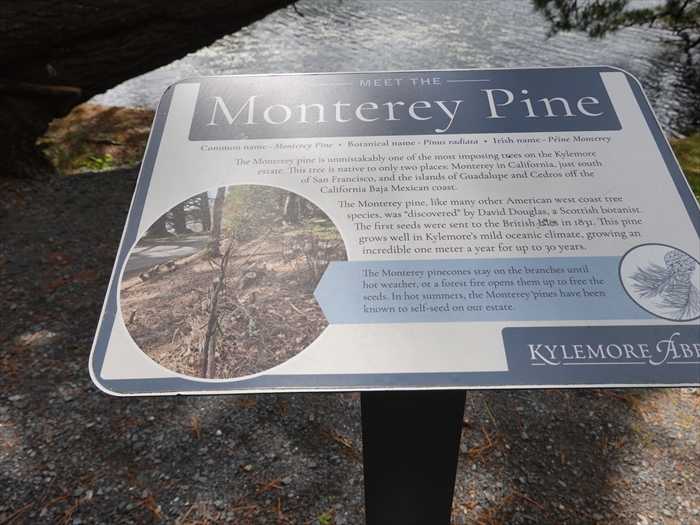
「Lake Walk」 を奥に進む。
「 Lake Walk
暑い夏には、敷地内で自然に発芽することも知られています。 】

「Lake Walk」 を奥に進む。
「 Lake Walk
The Kylemore Valley is rich in geological heritage.
Our estate is part of the Joyce Country & Western Lakes aspiring UNESCO Global Geopark (Gleann Uí Dhálaigh agus Lochanna an Iarthair) and the bedrock of Kylemore Valley is
of great geological importance of a foreign landmass, and its influence on the local
heritage, communities, and biodiversity.
of great geological importance of a foreign landmass, and its influence on the local
heritage, communities, and biodiversity.
The bedrock of Kylemore Valley is mainly metamorphic rocks dating back to 700 million
years ago: quartzite for the peaks, schist and marble for the valley floor. The last Ice Age
had a major influence on the landscape.」
【 レイク・ウォーク
years ago: quartzite for the peaks, schist and marble for the valley floor. The last Ice Age
had a major influence on the landscape.」
【 レイク・ウォーク
カイルモア渓谷は、豊かな地質遺産を有しています。
当敷地は、「ジョイス・カントリー & 西部湖沼群」のユネスコ世界ジオパーク申請地域の一部
であり(アイルランド語名:Gleann Uí Dhálaigh agus Lochanna an Iarthair)、
カイルモア渓谷の基盤岩は、かつての外来の大陸地塊に由来し、地元の文化遺産、地域社会、
生物多様性に大きな影響を与えています。
であり(アイルランド語名:Gleann Uí Dhálaigh agus Lochanna an Iarthair)、
カイルモア渓谷の基盤岩は、かつての外来の大陸地塊に由来し、地元の文化遺産、地域社会、
生物多様性に大きな影響を与えています。
カイルモア渓谷の基盤岩は主に変成岩で、約7億年前にさかのぼるものです。山頂部には石英岩、
谷底には片岩や大理石が見られます。最終氷期もこの景観に大きな影響を及ぼしました。】

そして「 Kylemore’s Neo-Gothic Church 」 に到着。
谷底には片岩や大理石が見られます。最終氷期もこの景観に大きな影響を及ぼしました。】

そして「 Kylemore’s Neo-Gothic Church 」 に到着。
「
Gothic Church
THE MINIATURE CATHEDRAL」
【 ゴシック教会 小さな大聖堂(ミニチュア・カテドラル) 】
【 ゴシック教会 小さな大聖堂(ミニチュア・カテドラル) 】

「 Gothic Church
THE MINIATURE CATHEDRAL
In 1874, Mitchell Henry and his adored wife Margaret went on holiday to Egypt.
It was a happy time in their lives. But tragedy struck on the River Nile. Margaret
contracted dysentery and sixteen days later, she died. She was only 45, a mother of nine.
It was a happy time in their lives. But tragedy struck on the River Nile. Margaret
contracted dysentery and sixteen days later, she died. She was only 45, a mother of nine.
“It is not our mistress we have lost, but our mother” said one tenant as the distraught
Mitchell lovingly brought home the body of his wife to rest in her beloved Kylemore.
Mitchell lovingly brought home the body of his wife to rest in her beloved Kylemore.
Mitchell wanted to show his love for Margaret in a way that would last through time,
and so he commissioned the architect J.F. Fuller to create a “cathedral in miniature” in her honour. This beautiful Neo-Gothic Church is his tribute to her.」
【 ゴシック教会
and so he commissioned the architect J.F. Fuller to create a “cathedral in miniature” in her honour. This beautiful Neo-Gothic Church is his tribute to her.」
【 ゴシック教会
小さな大聖堂(ミニチュア・カテドラル)
1874年、ミッチェル・ヘンリーは最愛の妻マーガレットと共にエジプトへ休暇に出かけました。
それは二人にとって幸せな時でした。ところがナイル川で悲劇が起こります。マーガレットは
赤痢にかかり、16日後に亡くなってしまいました。彼女はまだ45歳で、9人の子どもを持つ母でした。
それは二人にとって幸せな時でした。ところがナイル川で悲劇が起こります。マーガレットは
赤痢にかかり、16日後に亡くなってしまいました。彼女はまだ45歳で、9人の子どもを持つ母でした。
「私たちが失ったのは奥様ではなく、母です」
と、ある小作人が語ったと伝えられています。打ちひしがれたミッチェルは、妻の遺体を愛する
カイルモアへと丁重に連れ帰りました。ミッチェルは、時を超えて妻マーガレットへの愛を
示したいと考え、建築家J.F.フラーに「ミニチュアの大聖堂」を設計させました。この美しい
ネオゴシック様式の教会は、彼女への追悼の証です。】
「 The gargoyles on the limestone exterior
カイルモアへと丁重に連れ帰りました。ミッチェルは、時を超えて妻マーガレットへの愛を
示したいと考え、建築家J.F.フラーに「ミニチュアの大聖堂」を設計させました。この美しい
ネオゴシック様式の教会は、彼女への追悼の証です。】
「 The gargoyles on the limestone exterior
are classic marks of cathedral architecture – but these are angelic creatures telling of
peace, setting the design apart from some of its more fearsome cousins from Europe.
The wolves of Ireland are set against a light-yellow sandstone from the North of France.
peace, setting the design apart from some of its more fearsome cousins from Europe.
The wolves of Ireland are set against a light-yellow sandstone from the North of France.
“The carvings of the interior are breathtaking,” say the experts – graceful and feminine
with delicately shaped flowers and birds of beauty incised in the sandstone. The superb
stained-glass windows remind us of the Five Virtues of Fortitude, Faith, Charity, Hope
and Chastity.
with delicately shaped flowers and birds of beauty incised in the sandstone. The superb
stained-glass windows remind us of the Five Virtues of Fortitude, Faith, Charity, Hope
and Chastity.
Originally, the Gothic Church was a place of Anglican worship. Following the arrival of the Benedictine Nuns to Kylemore in 1920, it was re-dedicated as a Catholic Church.
The Mausoleum containing the remains of Margaret and Mitchell Henry is a short distance
to the east of the church.」
【石灰岩の外壁に見られるガーゴイル像
The Mausoleum containing the remains of Margaret and Mitchell Henry is a short distance
to the east of the church.」
【石灰岩の外壁に見られるガーゴイル像
は、大聖堂建築の典型的な意匠ですが、ここでは平和を象徴する天使的存在として表現されており、
ヨーロッパの他の恐ろしげなガーゴイルとは異なる雰囲気を醸し出しています。アイルランドの
オオカミは、フランス北部の淡黄色の砂岩を背景に彫刻されています。
ヨーロッパの他の恐ろしげなガーゴイルとは異なる雰囲気を醸し出しています。アイルランドの
オオカミは、フランス北部の淡黄色の砂岩を背景に彫刻されています。
「内部の彫刻は息を呑むほど美しい」と専門家は評しています。優雅で女性的な様式で、繊細に
形づくられた花々や美しい鳥が砂岩に刻まれています。素晴らしいステンドグラスは、「五つの徳」
──勇気・信仰・慈善・希望・純潔──を想起させます。
形づくられた花々や美しい鳥が砂岩に刻まれています。素晴らしいステンドグラスは、「五つの徳」
──勇気・信仰・慈善・希望・純潔──を想起させます。
もともとこのゴシック教会は、英国国教会(聖公会)の礼拝所として建てられたものでした。
1920年にベネディクト会の修道女たちがカイルモアに到着した後、カトリック教会として
再奉献されました。マーガレットとミッチェル・ヘンリーの遺骨が納められた霊廟
(マウソレウム)は、教会の東側すぐの場所にあります。】
「Next to the church lies the cemetery of the Benedictine community of Kylemore Abbey,
1920年にベネディクト会の修道女たちがカイルモアに到着した後、カトリック教会として
再奉献されました。マーガレットとミッチェル・ヘンリーの遺骨が納められた霊廟
(マウソレウム)は、教会の東側すぐの場所にあります。】
「Next to the church lies the cemetery of the Benedictine community of Kylemore Abbey,
which is still in use today. You will notice that some of the earlier graves bear names
with a French, German or Belgian origin, testament to the nuns of those regions that
first arrived in the community when it was re-established at Kylemore. This graveyard is
full of Benedictine nuns – that of a schoolgirl, Ruth Stoker who died of a childhood illness
while she was a pupil here in 1923.
with a French, German or Belgian origin, testament to the nuns of those regions that
first arrived in the community when it was re-established at Kylemore. This graveyard is
full of Benedictine nuns – that of a schoolgirl, Ruth Stoker who died of a childhood illness
while she was a pupil here in 1923.
Today the church is used to host musical recitals, poetry readings and cross-community celebrations. It will always be what it originally was – Margaret’s Memorial, created by
her loving husband.」
【この教会のすぐ隣には、カイルモア修道院に属するベネディクト会修道女たちの墓地があります。
her loving husband.」
【この教会のすぐ隣には、カイルモア修道院に属するベネディクト会修道女たちの墓地があります。
この墓地は今も現役で使われており、初期の墓石にはフランス語・ドイツ語・ベルギー系の名前が
見られます。これは、カイルモアに再定住した初期の修道女たちがこれらの地域から来たことを
物語っています。ここには数多くのベネディクト会の修道女たちが眠っており、中には1923年に
この地で病気により亡くなった女学生、ルース・ストーカーの墓もあります。
見られます。これは、カイルモアに再定住した初期の修道女たちがこれらの地域から来たことを
物語っています。ここには数多くのベネディクト会の修道女たちが眠っており、中には1923年に
この地で病気により亡くなった女学生、ルース・ストーカーの墓もあります。
現在この教会は、音楽リサイタルや詩の朗読会、地域を越えた共同の祝祭の場としても利用されて
います。しかし、何よりも本来の目的──愛する妻マーガレットの追悼の場──として、
この教会の本質は今も変わっていません。】
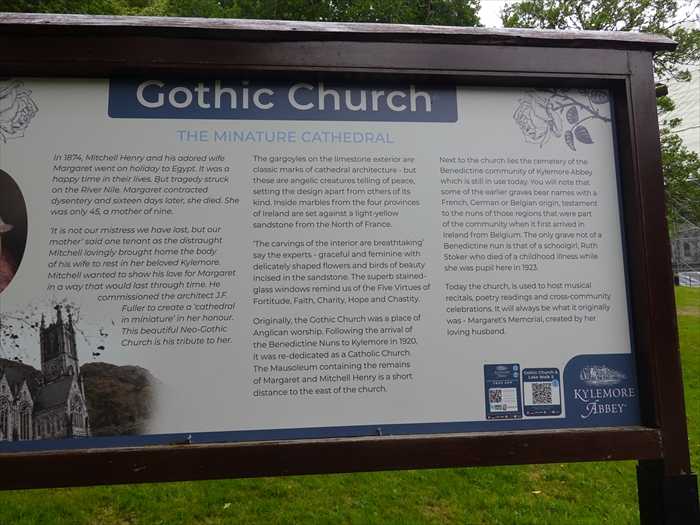
尖塔は工事中 であったが、カイルモア修道院(Kylemore Abbey)のNeo-Gothic Church
(ネオ・ゴシック教会)の外観は、まさに「ミニチュア大聖堂」と呼ばれるにふさわしい
荘厳さと繊細さを兼ね備えていたのであった。
スコットランドの建築家 J.F. フラー(James Franklin Fuller) によって設計され、1877年に
完成した と。

以下、2枚の写真はネットから。
この教会は19世紀に建てられたゴシック・リヴァイヴァル様式の礼拝堂で、
ヘンリー・ミッチェルが亡き妻マーガレットの追悼のために建てた記念教会。
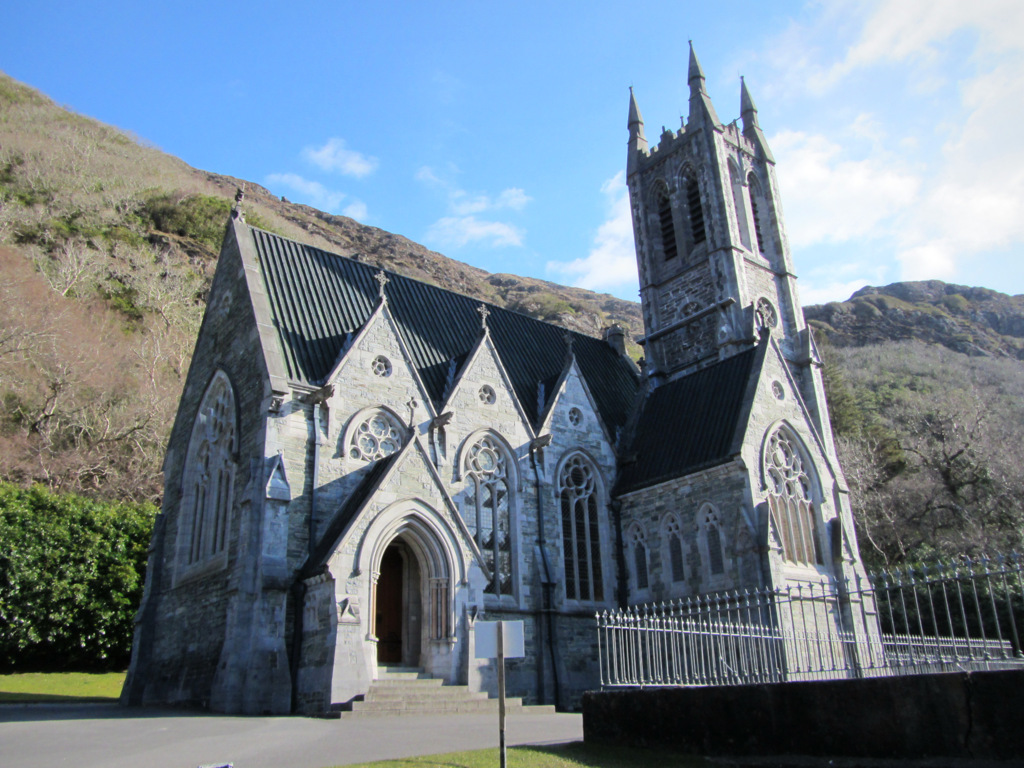

ネオ・ゴシック様式(19世紀に流行したゴシック建築の復興様式)で建てられており、本格的な
ゴシック大聖堂を小型化したような荘厳な造り。
地元コネマラ地方の石材を使用しており、色合いの異なる石(灰色の片岩、黄色がかった砂岩など)
がバランスよく組み合わされていた。
Internally, the main visible symptoms of this were the extensive mould growth which
covered much of the interior whenever the weather was wet and stagnant water falling
from a water soaked clean stone walls and ceiling.
During the restoration work the external stone work was cleaned and repointed.
The conservation work involved repairs to:the main roof ,floors and roof of the tower,
the leaded windows,conservation and repair of ironworks,rainwater goods and joinery.
All marble columns were installed.Restoration works were reprogrammed when it was
found that the main roof is home to the largest known colony of Natterer's bats in
Ireland.Great care was taken to ensure that the bats were not disturbed.The colony has
since bred succsessfully every year.」
【修復が始まる前、この教会は深刻な損傷を受けていました。
それは、劣化した銅屋根の鉛板や外壁の目地部分から水が浸入していたことによるものでした。
内部では、その主な目に見える症状として、雨が降るたびに室内の広い範囲にカビが繁殖し、
さらに水を吸った石壁や天井から停滞した水が滴り落ちるという状態が発生していました。
修復作業中、外壁の石材は洗浄され、再度目地(リポイント)処理が施されました。
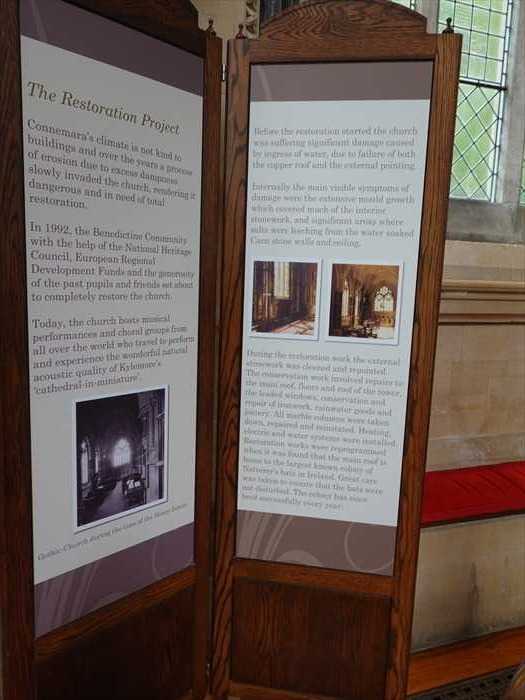
修復された壁等の写真。
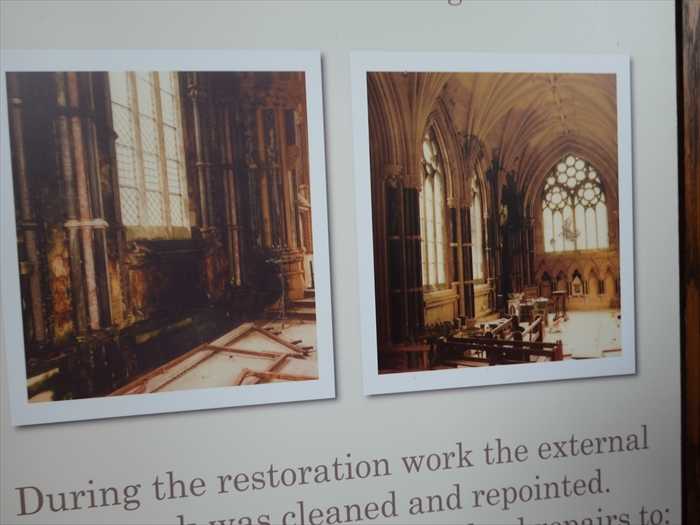
「PAX – Peace
A welcome from the Mother Abbess
In 1867 the Mitchell Henry family built Kylemore Castle and subsequently this beautiful
Neo-Gothic Church which was used by the family for their term of residence there,
terminated by tragic circumstances.
In 1920 the Benedictine nuns arriving from Ypres in Belgium bought the property and
the castle became Kylemore Abbey.
The Abbey and this church have become a centre of hospitality and admiration for visitors
to the West of Ireland and this exquisite scenic beauty.
The church has become a source of joy and satisfaction to all who visit and we are glad to
share with you the pleasure and peace of this architectural treasure.
We hope you will enjoy your visit and that our prayers and message of peace and heritage
will bless you.
You are most welcome in the name of the Benedictine tradition of Kylemore Abbey.
います。しかし、何よりも本来の目的──愛する妻マーガレットの追悼の場──として、
この教会の本質は今も変わっていません。】

尖塔は工事中 であったが、カイルモア修道院(Kylemore Abbey)のNeo-Gothic Church
(ネオ・ゴシック教会)の外観は、まさに「ミニチュア大聖堂」と呼ばれるにふさわしい
荘厳さと繊細さを兼ね備えていたのであった。
スコットランドの建築家 J.F. フラー(James Franklin Fuller) によって設計され、1877年に
完成した と。

以下、2枚の写真はネットから。
この教会は19世紀に建てられたゴシック・リヴァイヴァル様式の礼拝堂で、
ヘンリー・ミッチェルが亡き妻マーガレットの追悼のために建てた記念教会。


ネオ・ゴシック様式(19世紀に流行したゴシック建築の復興様式)で建てられており、本格的な
ゴシック大聖堂を小型化したような荘厳な造り。
地元コネマラ地方の石材を使用しており、色合いの異なる石(灰色の片岩、黄色がかった砂岩など)
がバランスよく組み合わされていた。
尖塔(せんとう):鋭く天に向かって伸びた塔が印象的で、ゴシック建築の象徴。
尖塔アーチの窓:縦長のアーチ状の窓が多く、内部のステンドグラスに自然光を取り込む。
バットレス(控え壁):外壁の補強として、教会周囲に飛び出した構造があり、垂直の力を
分散させる役割も。
分散させる役割も。
装飾彫刻:外壁の随所に花や鳥の彫刻が施されており、宗教的な象徴性と美を兼ねていた。

尖塔は工事用シートに覆われていた。

ファザード 。
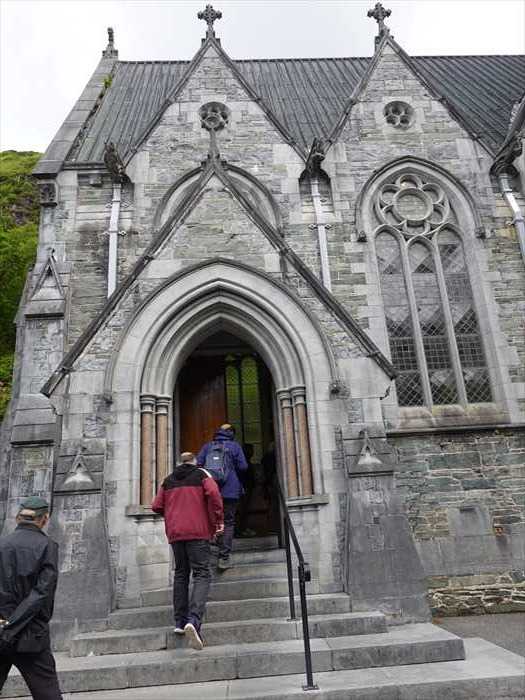
教会内部の天井。
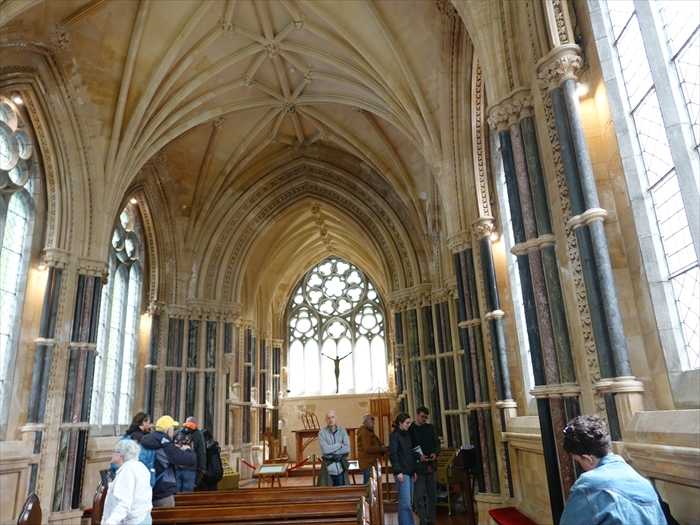
アーチの輪郭にはレース状の石細工(トレサリー:tracery)が施されており、葉の彫刻が
精巧に組み込まれていた。
各アーチの内部上部にある円形の装飾には、花(おそらくバラかアザミ)を模した彫刻が。
これはヴィクトリア朝時代によく見られるモチーフであり、自然と美を象徴 と。
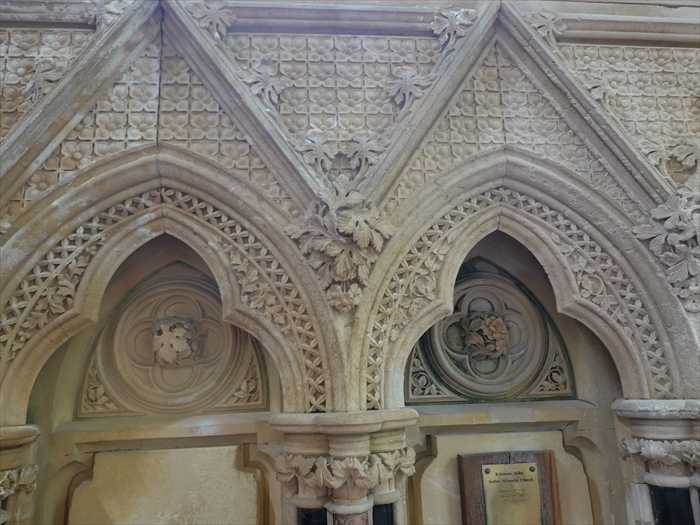
正面の祭壇方向を再び。

ズームして。
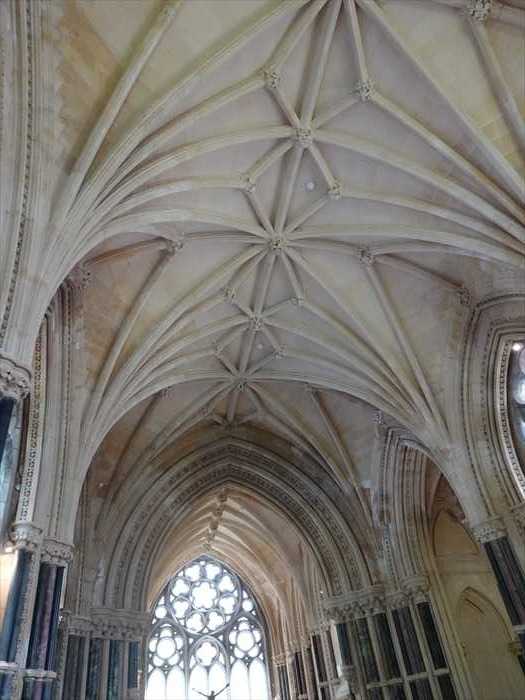
左:「 The Restoration Project

尖塔は工事用シートに覆われていた。

ファザード 。

教会内部の天井。
教会の天井は尖頭ヴォールト(pointed vault)構造で、リブ(梁)が美しく交差し、
天へと導くような印象を与えてくれるのであった。
天へと導くような印象を与えてくれるのであった。
ゴシック建築特有の「垂直性」を強調することで、信仰の高みを感じさせる空間構成に。

アーチの輪郭にはレース状の石細工(トレサリー:tracery)が施されており、葉の彫刻が
精巧に組み込まれていた。
各アーチの内部上部にある円形の装飾には、花(おそらくバラかアザミ)を模した彫刻が。
これはヴィクトリア朝時代によく見られるモチーフであり、自然と美を象徴 と。

正面の祭壇方向を再び。

ズームして。

左:「 The Restoration Project
Connemara’s climate is not kind to buildings and over the years a process of erosion
and decay – driven by storms, wind, and wet – weakened the church, rendering it
dangerous and in need of total restoration.
and decay – driven by storms, wind, and wet – weakened the church, rendering it
dangerous and in need of total restoration.
In 1992, the Benedictine Community with the help of the National Heritage Council,
the Department of the Environment and generous philanthropic and donor support,
devised plans and raised the funds to completely restore the church.
the Department of the Environment and generous philanthropic and donor support,
devised plans and raised the funds to completely restore the church.
Today, the church hosts musical performances and liturgies and offers visitors a chance
to enjoy the acoustical quality and experience the wonder of Kylemore’s
“cathedral-in-miniature”.
to enjoy the acoustical quality and experience the wonder of Kylemore’s
“cathedral-in-miniature”.
Gothic Church during the time of the Henry family.」
【コネマラの気候は建物に厳しく、年月とともに嵐、風、湿気による侵食と劣化が進み、教会の
構造は弱体化し、危険な状態に陥っていました。完全な修復が必要となったのです。
1992年、ベネディクト会の修道女たちは、アイルランド国家遺産評議会、環境省、そして多くの
寄付者や支援者の助けを得て、教会の完全修復に向けた計画を立て、資金を集めました。
現在、この教会では音楽の演奏や典礼が行われ、訪問者は音響の美しさと「ミニチュアの大聖堂」
と称されるカイルモアの教会の魅力を体感することができます。
写真はヘンリー家の時代のゴシック教会】

右:「Before the restoration started the church was suffering significant damage caused
by water ingress under the decayed lead of the copper roof and the external pointing.
【コネマラの気候は建物に厳しく、年月とともに嵐、風、湿気による侵食と劣化が進み、教会の
構造は弱体化し、危険な状態に陥っていました。完全な修復が必要となったのです。
1992年、ベネディクト会の修道女たちは、アイルランド国家遺産評議会、環境省、そして多くの
寄付者や支援者の助けを得て、教会の完全修復に向けた計画を立て、資金を集めました。
現在、この教会では音楽の演奏や典礼が行われ、訪問者は音響の美しさと「ミニチュアの大聖堂」
と称されるカイルモアの教会の魅力を体感することができます。
写真はヘンリー家の時代のゴシック教会】

右:「Before the restoration started the church was suffering significant damage caused
by water ingress under the decayed lead of the copper roof and the external pointing.
Internally, the main visible symptoms of this were the extensive mould growth which
covered much of the interior whenever the weather was wet and stagnant water falling
from a water soaked clean stone walls and ceiling.
During the restoration work the external stone work was cleaned and repointed.
The conservation work involved repairs to:the main roof ,floors and roof of the tower,
the leaded windows,conservation and repair of ironworks,rainwater goods and joinery.
All marble columns were installed.Restoration works were reprogrammed when it was
found that the main roof is home to the largest known colony of Natterer's bats in
Ireland.Great care was taken to ensure that the bats were not disturbed.The colony has
since bred succsessfully every year.」
【修復が始まる前、この教会は深刻な損傷を受けていました。
それは、劣化した銅屋根の鉛板や外壁の目地部分から水が浸入していたことによるものでした。
内部では、その主な目に見える症状として、雨が降るたびに室内の広い範囲にカビが繁殖し、
さらに水を吸った石壁や天井から停滞した水が滴り落ちるという状態が発生していました。
修復作業中、外壁の石材は洗浄され、再度目地(リポイント)処理が施されました。
保存修復には以下の修繕が含まれていました:
・主屋根、床、および塔屋の屋根の修理
・鉛ガラス窓の修復
・鉄製装飾の保存・修復
・雨樋や木工細工(ジョイナリー)の修繕
また、すべての大理石製の柱が設置されました。
作業の途中で、主屋根がアイルランド最大級のナターレコウモリ(Natterer’s bat)の生息地で
あることが判明し、工事はそれに配慮して再調整されました。
あることが判明し、工事はそれに配慮して再調整されました。
コウモリの邪魔にならないよう、細心の注意が払われました。
それ以来、このコロニーは毎年順調に増殖を続けています。】

修復された壁等の写真。

「PAX – Peace
A welcome from the Mother Abbess
In 1867 the Mitchell Henry family built Kylemore Castle and subsequently this beautiful
Neo-Gothic Church which was used by the family for their term of residence there,
terminated by tragic circumstances.
In 1920 the Benedictine nuns arriving from Ypres in Belgium bought the property and
the castle became Kylemore Abbey.
The Abbey and this church have become a centre of hospitality and admiration for visitors
to the West of Ireland and this exquisite scenic beauty.
The church has become a source of joy and satisfaction to all who visit and we are glad to
share with you the pleasure and peace of this architectural treasure.
We hope you will enjoy your visit and that our prayers and message of peace and heritage
will bless you.
You are most welcome in the name of the Benedictine tradition of Kylemore Abbey.
M. Clare Morety O.S.B. (Abbess)」
【 PAX – 平和
【 PAX – 平和
修道院長より皆さまへようこそ
1867年、ミッチェル・ヘンリー一家はカイルモア城を建て、その後この美しいネオ・ゴシック
様式の教会を建立しました。この教会は家族の滞在期間中、私的な礼拝の場として使われて
いましたが、不幸な事情によりその使用は終わりを迎えました。
様式の教会を建立しました。この教会は家族の滞在期間中、私的な礼拝の場として使われて
いましたが、不幸な事情によりその使用は終わりを迎えました。
1920年、ベルギーのイーペルから到着したベネディクト会の修道女たちがこの地所を取得し、
城は「カイルモア修道院」となりました。
城は「カイルモア修道院」となりました。
以来、修道院とこの教会は、西アイルランドを訪れる人々にとってのおもてなしと感嘆の中心と
なり、周囲の風光明媚な景観とともに多くの人に愛されています。
なり、周囲の風光明媚な景観とともに多くの人に愛されています。
この教会は訪れるすべての人にとって喜びと満足の源となっており、私たちはこの建築的宝物から
得られる平和と喜びを皆さまと分かち合えることを嬉しく思っています。
得られる平和と喜びを皆さまと分かち合えることを嬉しく思っています。
あなたの訪問が喜びに満ち、私たちの祈りと平和のメッセージ、そしてこの遺産があなたを
祝福しますように。
祝福しますように。
ベネディクト会の伝統に基づき、カイルモア修道院より心から歓迎いたします。
M・クレア・モレティ修道院長 O.S.B.(ベネディクト会)】
「 The Gothic 'Memorial' Church
「 The Gothic 'Memorial' Church
As a tribute to his late wife Margaret, Mitchell Henry commissioned a magnificent
neo-gothic church in her memory.The“cathedral-in-miniature.”was designed by J. Fuller and embodies an almost-feminine aspect with its interior of light
neo-gothic church in her memory.The“cathedral-in-miniature.”was designed by J. Fuller and embodies an almost-feminine aspect with its interior of light
Caen sandstone,angel in place of gargoyles,beautiful marble pillars and exquisite stone
carvings.The marble pillars come from the four provinces of Ireland:green fron Connemara (Connaught), rose from Cork (Munster),black from Kilkenny (Leinster).and grey from Armagh(Ulster).There is only one stained glass window.Located in the south transept,
it depicts the five graces: Fortitude, Faith, Charity, Hope, and Chastity.」
【ゴシック様式の「記念」教会
ミッチェル・ヘンリーは、亡き妻マーガレットへの追悼として、壮麗なネオ・ゴシック様式の
教会を建てることを依頼しました。
彼が「ミニチュアの大聖堂」と呼んだこの教会は、J・フラーによって設計され、内部は明るい
カーン石(Caen sandstone)で仕上げられており、全体にどこか女性的な美しさを漂わせて
います。ガーゴイルの代わりに天使像が配され、美しい大理石の柱と精巧な石の彫刻がその
特徴です。
柱に使われている大理石は、アイルランドの四つの地方から採取されたもので、それぞれの色が
異なります:
・緑色:コネマラ(コノート地方)<
・バラ色:コーク(マンスター地方)
黒色:キルケニー(レンスター地方)
・灰色:アーマー(アルスター地方)
ステンドグラスはただ一枚だけで、南翼廊(サウス・トランセプト)に設置されています。
その窓には「五つの恩恵(グレース)」――
勇気(Fortitude)・信仰(Faith)・慈愛(Charity)・希望(Hope)・貞潔(Chastity)が
描かれています。】
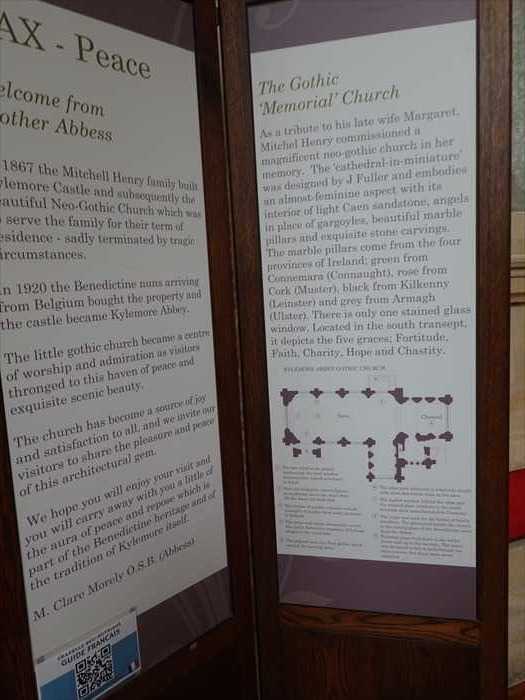
「 KYLEMORE ABBEY GOTHIC CHURCH 」
1.Nave – the central aisle
2.Side aisle – a passage running parallel to the nave
3.Narthex – entrance or lobby area
4.Choir – where the choir or clergy sits
5.Sanctuary – sacred area around the altar
6.Apse – semicircular or polygonal area at end of choir
7.Transept – arm of the cross-shaped church
8.Vestry – room where vestments and sacred items are kept
9.Tower – architectural feature rising above the church
10.Buttresses – exterior supports to strengthen the walls
11.Rose window – circular stained glass window
12.Confessionals – private spaces for sacrament of confession
13.Chapel niches – recessed spaces for devotional altars
14.Burial vault – final resting place of Margaret Henry
【カイルモア修道院 ゴシック教会 建築図解
1.身廊(ネイブ) – 教会の中央通路
2.側廊(サイド・アイル) – 中央通路と並行する通路
3.ナルテックス – 入口部分またはロビーエリア
4.聖歌隊席(クワイア) – 聖歌隊や聖職者が座る場所<
5.内陣(サンクチュアリ) – 祭壇周囲の神聖な区域
6.アプス – 半円形または多角形の後陣部分
7.翼廊(トランセプト) – 十字形平面の横部分<
8.聖具室(ヴェストリー) – 祭服や聖具を保管する部屋
9.塔(タワー) – 教会の上部にそびえる構造物
10.控え壁(バットレス) – 壁の強化用外部支柱
11.バラ窓(ローズウィンドウ) – 円形ステンドグラス窓
12.告解室(コンフェッショナル) – 告解のための個室
13.小礼拝室(チャペル・ニッチ) – 小さな祭壇のあるくぼみ
14.納骨室(バリアル・ヴォールト) – マーガレット・ヘンリーの埋葬場所】
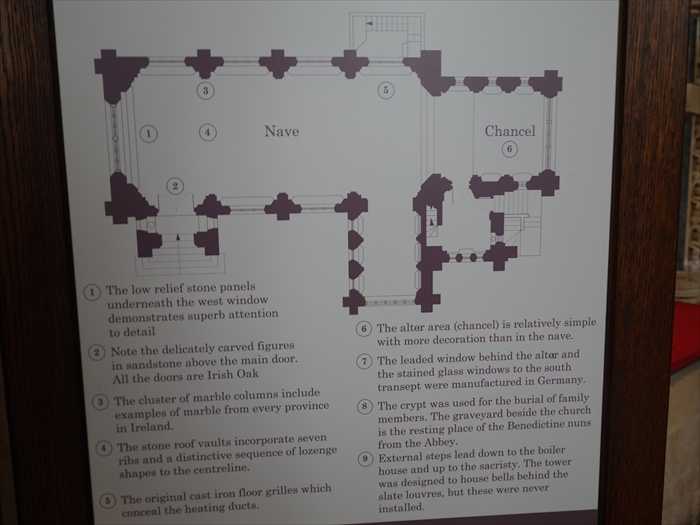
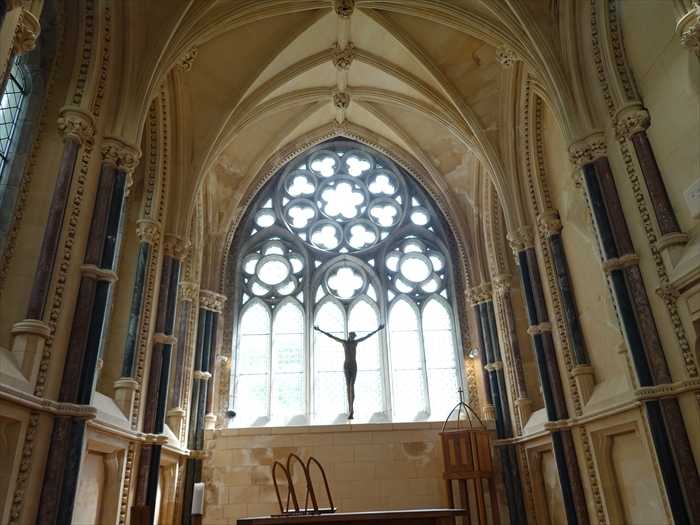
「 CHRIST, 2003, Kylemore Abbey, Connemara
carvings.The marble pillars come from the four provinces of Ireland:green fron Connemara (Connaught), rose from Cork (Munster),black from Kilkenny (Leinster).and grey from Armagh(Ulster).There is only one stained glass window.Located in the south transept,
it depicts the five graces: Fortitude, Faith, Charity, Hope, and Chastity.」
【ゴシック様式の「記念」教会
ミッチェル・ヘンリーは、亡き妻マーガレットへの追悼として、壮麗なネオ・ゴシック様式の
教会を建てることを依頼しました。
彼が「ミニチュアの大聖堂」と呼んだこの教会は、J・フラーによって設計され、内部は明るい
カーン石(Caen sandstone)で仕上げられており、全体にどこか女性的な美しさを漂わせて
います。ガーゴイルの代わりに天使像が配され、美しい大理石の柱と精巧な石の彫刻がその
特徴です。
柱に使われている大理石は、アイルランドの四つの地方から採取されたもので、それぞれの色が
異なります:
・緑色:コネマラ(コノート地方)<
・バラ色:コーク(マンスター地方)
黒色:キルケニー(レンスター地方)
・灰色:アーマー(アルスター地方)
ステンドグラスはただ一枚だけで、南翼廊(サウス・トランセプト)に設置されています。
その窓には「五つの恩恵(グレース)」――
勇気(Fortitude)・信仰(Faith)・慈愛(Charity)・希望(Hope)・貞潔(Chastity)が
描かれています。】

「 KYLEMORE ABBEY GOTHIC CHURCH 」
1.Nave – the central aisle
2.Side aisle – a passage running parallel to the nave
3.Narthex – entrance or lobby area
4.Choir – where the choir or clergy sits
5.Sanctuary – sacred area around the altar
6.Apse – semicircular or polygonal area at end of choir
7.Transept – arm of the cross-shaped church
8.Vestry – room where vestments and sacred items are kept
9.Tower – architectural feature rising above the church
10.Buttresses – exterior supports to strengthen the walls
11.Rose window – circular stained glass window
12.Confessionals – private spaces for sacrament of confession
13.Chapel niches – recessed spaces for devotional altars
14.Burial vault – final resting place of Margaret Henry
【カイルモア修道院 ゴシック教会 建築図解
1.身廊(ネイブ) – 教会の中央通路
2.側廊(サイド・アイル) – 中央通路と並行する通路
3.ナルテックス – 入口部分またはロビーエリア
4.聖歌隊席(クワイア) – 聖歌隊や聖職者が座る場所<
5.内陣(サンクチュアリ) – 祭壇周囲の神聖な区域
6.アプス – 半円形または多角形の後陣部分
7.翼廊(トランセプト) – 十字形平面の横部分<
8.聖具室(ヴェストリー) – 祭服や聖具を保管する部屋
9.塔(タワー) – 教会の上部にそびえる構造物
10.控え壁(バットレス) – 壁の強化用外部支柱
11.バラ窓(ローズウィンドウ) – 円形ステンドグラス窓
12.告解室(コンフェッショナル) – 告解のための個室
13.小礼拝室(チャペル・ニッチ) – 小さな祭壇のあるくぼみ
14.納骨室(バリアル・ヴォールト) – マーガレット・ヘンリーの埋葬場所】


「 CHRIST, 2003, Kylemore Abbey, Connemara
Bronze, 130 cm
Rowan Fergus Meredith Gillespie is an Irish bronze casting sculptor of international
acclaim. Born in Dublin to Irish parents, Gillespie spent his formative years in Cyprus.
acclaim. Born in Dublin to Irish parents, Gillespie spent his formative years in Cyprus.
His singular often exhausting modus operandi involves taking the work through from
conception to creation, entirely unassisted in his purpose-built bronze casting foundry at Blackrock, Co. Dublin. This is one of the things that makes him unique among the bronze
casting fraternity.
conception to creation, entirely unassisted in his purpose-built bronze casting foundry at Blackrock, Co. Dublin. This is one of the things that makes him unique among the bronze
casting fraternity.
Influenced by the sculptor Henry Moore and the painter Edvard Munch, Gillespie uses
the lost wax casting process to portray the whole gamut of human emotions. Having
worked almost exclusively on site-specific art since 1996, Gillespie’s public works can be
found in his native Ireland, Europe, the USA and Canada.
the lost wax casting process to portray the whole gamut of human emotions. Having
worked almost exclusively on site-specific art since 1996, Gillespie’s public works can be
found in his native Ireland, Europe, the USA and Canada.
Following the restoration of the Gothic Church at Kylemore Abbey, Rowan Gillespie was commissioned to create a sculpture of Christ. The sculpture was completed in 2003.
The donor for this work is Martin Hart from the USA.」
【 「キリスト」2003年、カイルモア修道院(コネマラ)
The donor for this work is Martin Hart from the USA.」
【 「キリスト」2003年、カイルモア修道院(コネマラ)
ブロンズ像、高さ130cm
ローワン・ファーガス・メレディス・ギレスピーは、国際的に高く評価されているアイルランドの
ブロンズ鋳造彫刻家です。ダブリンでアイルランド人の両親のもとに生まれ、幼少期はキプロスで
過ごしました。
ブロンズ鋳造彫刻家です。ダブリンでアイルランド人の両親のもとに生まれ、幼少期はキプロスで
過ごしました。
彼の独自で、しばしば過酷ともいえる制作手法は、構想から完成に至るまでの全工程を、
ダブリン県ブラックロックにある専用のブロンズ鋳造工房で完全に一人で行うという点にあります。
これこそが、彼をブロンズ彫刻の世界で唯一無二の存在とする要素のひとつです。
ダブリン県ブラックロックにある専用のブロンズ鋳造工房で完全に一人で行うという点にあります。
これこそが、彼をブロンズ彫刻の世界で唯一無二の存在とする要素のひとつです。
彫刻家ヘンリー・ムーアや画家エドヴァルド・ムンクの影響を受けたギレスピーは、人間のあらゆる
感情を表現するために「ロストワックス鋳造法」を用いています。1996年以降、彼はほぼすべての
作品を特定の場所のために制作するサイトスペシフィック・アートとして取り組んでおり、彼の
公共彫刻作品は、アイルランド国内のほか、ヨーロッパ、アメリカ、カナダでも見ることが
できます。
感情を表現するために「ロストワックス鋳造法」を用いています。1996年以降、彼はほぼすべての
作品を特定の場所のために制作するサイトスペシフィック・アートとして取り組んでおり、彼の
公共彫刻作品は、アイルランド国内のほか、ヨーロッパ、アメリカ、カナダでも見ることが
できます。
カイルモア修道院のゴシック教会が修復された後、ギレスピーはキリスト像の制作を依頼されました。
この彫刻は2003年に完成しました。
この彫刻は2003年に完成しました。
この作品の寄贈者は、アメリカ合衆国のマーティン・ハート氏】
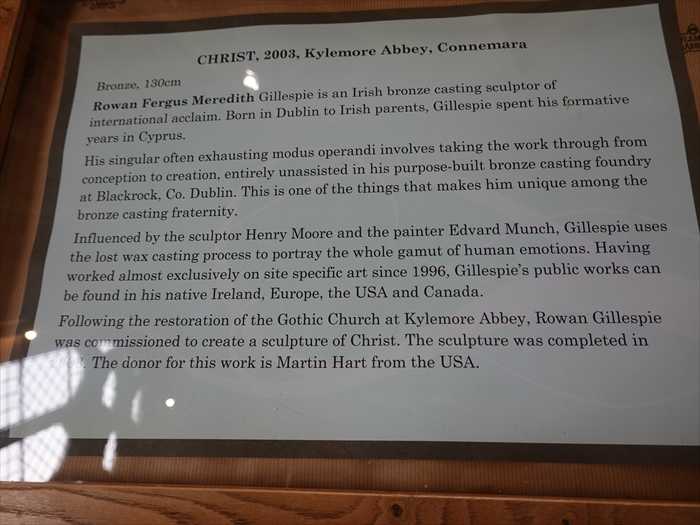
「 The Furniture Maker

「 The Furniture Maker
Michael Bell and his team of craftsmen make contemporary furniture using traditional
cabinet making techniques, specialising in Irish hardwoods, which are matched for
colour and grain pattern.
cabinet making techniques, specialising in Irish hardwoods, which are matched for
colour and grain pattern.
Inspiration
Inspired by the beautifully restored ‘Cathedral in Miniature’, the chancel pieces are simple
and well made, picking up on some of the church’s architectural details.
and well made, picking up on some of the church’s architectural details.
Arched Stretchers span the underframe of the Irish elm altar echoing the ceiling’s vaulted
arches; each of the altar’s four legs are composed of a trio of turned maple posts,
to reflect the cluster of coloured marble columns of the church.
arches; each of the altar’s four legs are composed of a trio of turned maple posts,
to reflect the cluster of coloured marble columns of the church.
The Wood
The contrasting timbers of maple and Irish elm were chosen for a chiaroscuro effect.
As elm is becoming increasingly rare, it was felt that it would be wonderful to use it in a
way that would live on.
As elm is becoming increasingly rare, it was felt that it would be wonderful to use it in a
way that would live on.
The maple tones in well with the Caen stone walls and accents the richly coloured elm.
The rest of the altar furniture pays homage to the Gothic detail. The curves of the Elm candlesticks melt into each other. The celebrant’s chair features a laminated black cross
in Elm, a maple frame and sculpted seat.
in Elm, a maple frame and sculpted seat.
Finally, all of the pieces are finished with six coats of oil. Each coat is buffed to a satiny
sheen and allowed to dry before the next coat is applied.」
【 家具職人
sheen and allowed to dry before the next coat is applied.」
【 家具職人
マイケル・ベルと彼の職人チームは、伝統的なキャビネット製作技術を用いて、アイルランド産の
広葉樹に特化した現代家具を製作しています。木の色合いや木目のパターンを合わせて使うのが
特徴です。
広葉樹に特化した現代家具を製作しています。木の色合いや木目のパターンを合わせて使うのが
特徴です。
インスピレーション
美しく修復された「ミニチュアの大聖堂(Cathedral in Miniature)」に着想を得て、内陣の家具は
シンプルながら丁寧に作られ、教会建築の装飾ディテールを取り入れています。
シンプルながら丁寧に作られ、教会建築の装飾ディテールを取り入れています。
アイルランド産エルム(ニレ)の祭壇の下部にはアーチ型の補強材(ストレッチャー)が渡され、
天井のヴォールト(アーチ状天井)を反映。祭壇の4本の脚は、3本ずつのメープル材の円柱から
成り、教会内の色とりどりの大理石柱の束を表現しています。
天井のヴォールト(アーチ状天井)を反映。祭壇の4本の脚は、3本ずつのメープル材の円柱から
成り、教会内の色とりどりの大理石柱の束を表現しています。
木材について
メープル材とアイルランド産エルム材というコントラストのある木材が、明暗表現
(キアロスクーロ)の効果を狙って選ばれました。エルムは今では希少となっており、
「永く生き続ける形で使えること」が大切だと考えられました。
(キアロスクーロ)の効果を狙って選ばれました。エルムは今では希少となっており、
「永く生き続ける形で使えること」が大切だと考えられました。
メープルの明るい色調は、教会のカーン石の壁ともよく調和し、エルムの深みある色合いを
引き立てています。
引き立てています。
祭壇用家具のその他の部分も、ゴシック様式の装飾美に敬意を表しています。
たとえばエルム材で作られた燭台の曲線は、互いに溶け合うようにデザインされており、司祭用の
椅子にはエルム材による黒い十字の象嵌、メープルの枠、そして彫刻された座面が組み合わされて
います。
椅子にはエルム材による黒い十字の象嵌、メープルの枠、そして彫刻された座面が組み合わされて
います。
最後に、すべての家具には6層のオイル仕上げが施されており、それぞれの層は光沢のある
サテン仕上げになるまで磨かれ、次の層を塗る前に十分に乾燥させられます。】

正面には美しいステンドグラス。

近づいて。
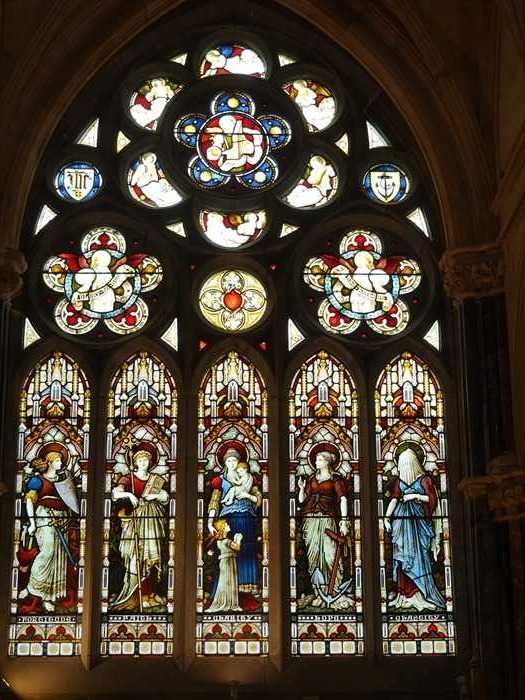
近づいて。
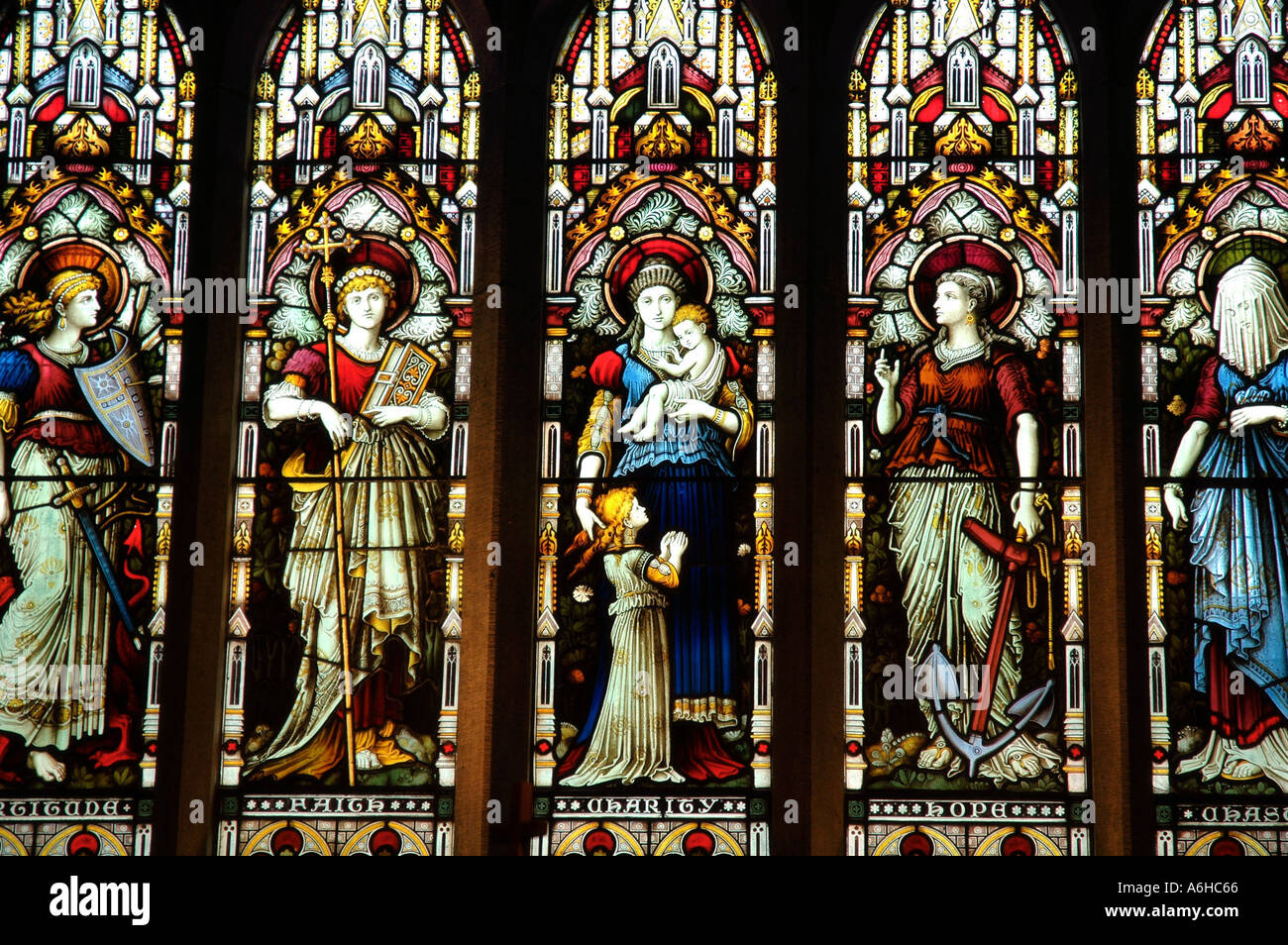
見上げて。
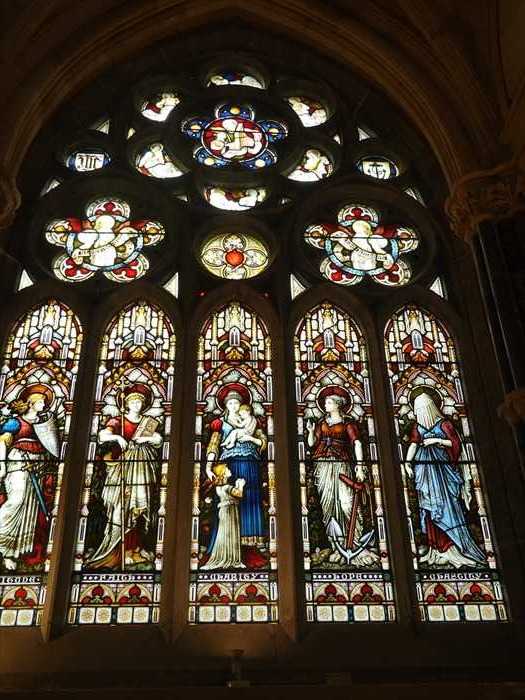
<キリストの受難あるいはゲッセマネの祈り (The Agony in the Garden) を描いたもの。
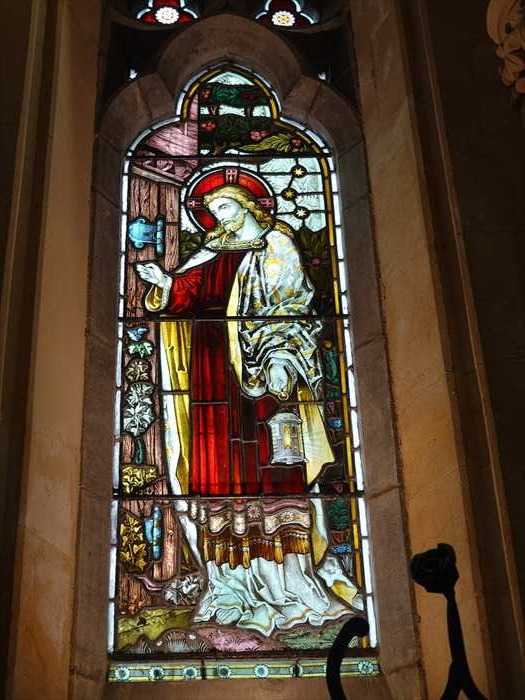
新約聖書に基づく場面・「イエスによる子どもの祝福」(Blessing of the Children)
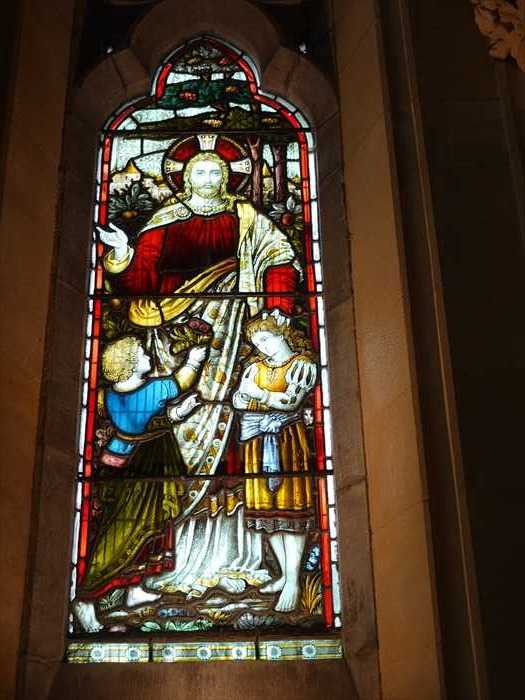
キリスト教美術における非常に象徴的なテーマである「良い羊飼い(The Good Shepherd)」を
描いたもの。
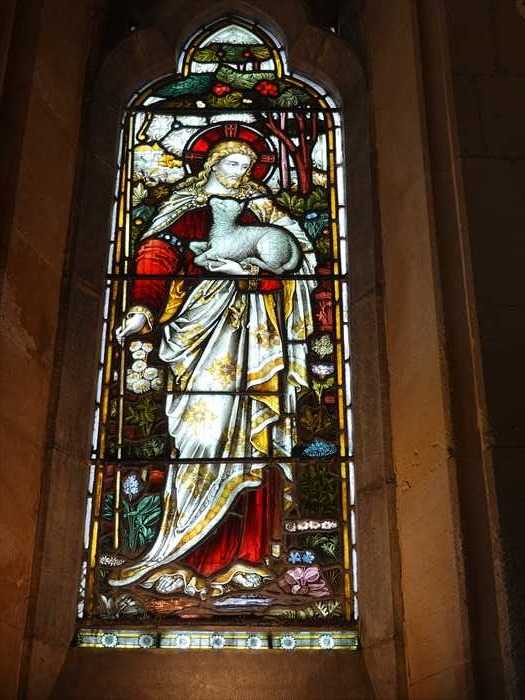
ステンドグラスの美を満喫して外へと。

紅葉時には。ネットから。

・・・ もどる ・・・
・・・ つづく ・・・
サテン仕上げになるまで磨かれ、次の層を塗る前に十分に乾燥させられます。】

正面には美しいステンドグラス。

近づいて。
上半円(バラ窓)
この部分には象徴的な意匠や紋章があり、中心には子羊(Agnus Dei:神の子羊)が十字架を
抱いている場面が描かれています。これはキリストの犠牲を象徴します。
抱いている場面が描かれています。これはキリストの犠牲を象徴します。
周囲の円には天使たちがラッパを吹いているような姿や、IHS(イエス・キリストのギリシャ語
頭文字)を表す記号も見られます。
頭文字)を表す記号も見られます。

近づいて。
下部の縦長パネル(5つの人物像)
それぞれの人物像は五つの恩恵(グレース)を象徴している。
画面右から順に以下のように解釈されます:
画面右から順に以下のように解釈されます:
FORTITUDE(勇気)
— 手に剣と盾を持ち、毅然と立つ女性像。勇気・強さ・試練に立ち向かう精神を表します。
FAITH(信仰)
— 聖書や十字架を掲げ、天を見上げる姿。神への信頼と確信を表す象徴的ポーズです。
CHARITY(慈愛)
— 子供を抱く女性。キリスト教において最も重要な美徳とされる愛(アガペー)を体現
しています。
しています。
HOPE(希望)
— 錨(アンカー)を手にする姿で描かれることが多く、この作品でも中央に錨のモチーフが
ある可能性があります。
ある可能性があります。
CHASTITY(貞潔)
— 白い衣をまとい、清らかさを象徴する花(たとえばユリ)などを持つ姿。純潔や誠実な
心を表します。
心を表します。
各人物の足元にその美徳の名称(例:FORTITUDE、CHARITYなど)が明記されていた。
下記写真はネットから。
下記写真はネットから。

見上げて。

<キリストの受難あるいはゲッセマネの祈り (The Agony in the Garden) を描いたもの。
イエス・キリストの頭部には後光(ハロー)と十字のニンバス(神性の象徴
)が。
赤いマントと白い衣、そして金色の縁取りは、王としての栄光と神性、人間性を同時に表して
いる のだ と。
いる のだ と。

新約聖書に基づく場面・「イエスによる子どもの祝福」(Blessing of the Children)
この場面は、以下のような聖書の言葉に基づいているとのこと。
「子どもたちをわたしのところに来させなさい。妨げてはならない。神の国はこのような者たちの
ものである。」― マルコによる福音書 10章14節
ものである。」― マルコによる福音書 10章14節
この言葉は、キリストの無垢な者への愛と、子どもの純粋さの価値を象徴しており、
ステンドグラス芸術でもよく取り上げられるテーマである と。
ステンドグラス芸術でもよく取り上げられるテーマである と。

キリスト教美術における非常に象徴的なテーマである「良い羊飼い(The Good Shepherd)」を
描いたもの。
この図像はヨハネによる福音書10章からの引用に基づく と。
「 わたしは良い羊飼いである。良い羊飼いは羊のために命を捨てる。
」
― ヨハネによる福音書 10-11
― ヨハネによる福音書 10-11
この比喩は、神がすべての信者(=羊)を見守り導く存在であるという福音の核心を成す重要な
象徴である と。
象徴である と。

ステンドグラスの美を満喫して外へと。

紅葉時には。ネットから。

・・・ もどる ・・・
・・・ つづく ・・・
お気に入りの記事を「いいね!」で応援しよう
【毎日開催】
15記事にいいね!で1ポイント
10秒滞在
いいね!
--
/
--
© Rakuten Group, Inc.










